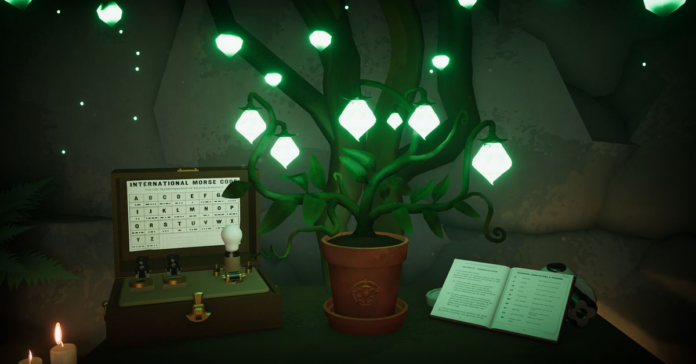Open up Botany Manor for the first time, and you’re immediately struck by, for lack of a better term, an overwhelmingly cozy vibe. This game oozes positivity and brightness; your ears get hit with what sounds like white noise, with a calming harp mixed in with the sounds of birds chirping and water running. The world around you is incredibly vivid, with intense, saturated colors for the trees and plants and soft-looking grass that crunches slightly under your feet as you walk. If you’re looking for a game that’s the definition of “cozy,” this would be toward the top of that list.
That vibe never changes throughout the game’s short run time, but this aggressively twee visage is only part of the story. While Botany Manor just tasks you with growing some rare plants, you quickly learn that it’s not so easy. All these plants require unique conditions to grow, like wind that blows at just the right speed or soil imbued with the correct amount of unexpected ingredients, which likely won’t be readily available. You’ll need to find the missing pieces, along with answers about your character’s history, across the sprawling Botany Manor.
The game gives you just the right amount of tools and information to go about your tasks, starting with a simple tutorial during which you’re tasked with growing one plant. For the most part, you have to figure out how to play by poking around and clicking on objects, bringing separate bits of information together to grow the plant. It’s not too complicated once you find what you need — and you’ll assign all the discovered clues to the appropriate plant in your journal, so it’s easy to keep track of it all — but that’s just the start. That tutorial then sets you up for much more difficult tasks later on.
Botany Manor isn’t a difficult game overall, but it’s more complex than you’d expect, with each puzzle intricately laid out in various areas of the estate. Many sections are initially closed off, and you can only unlock them by solving puzzles. Sometimes somebody will deliver a key to your home at the front gate after you’ve grown a certain number of plants, or solving a puzzle will unlock a secret area. You’ll have to check your map often as you go about your quests.
But within that complexity is a streamlined attention to detail. This becomes clear as you progress, with one room giving you a clue about something you’ve likely already seen in another. You’ll see a lab setup, for example, and find a note in a nearby room about how you’ll need to combine some chemicals to get a material you can then use to help grow a plant. There’s not a lot of subtlety in how the clues are presented, either. They’re usually on notes you’ll find scattered throughout the manor or on bottles and other objects, and they spell out what you need without saying specifically how to use it. In the chemical example, you’ll find a recipe on a bottle, but you’ll need to find another note that says what the bottle contains, why you need to make your own, and what it’s for.
The game also generally keeps you to similar, nearby areas so you don’t have to wander too far to find clues. As you progress, the areas will become more spread out; what was once confined to two rooms might now be across multiple areas on the grounds. Still, they’ll all be connected. You might need to go into rooms that are slightly off the beaten path, but they’re likely ones you’ve already visited and couldn’t do anything in just yet.
This might all seem like standard puzzle game fare, but Botany Manor makes it all feel so simple. Even if you’ve never played a game like this before and you didn’t do well during the tutorial section, it’ll still streamline the experience until it feels like second nature to walk around, grab notes, and record them in your journal. The game’s puzzles will gradually get more intricate, but you’ll use the same skills the entire time. In that way, while Botany Manor might hide something more complex under its “cozy” demeanor, it’s still a cozy game. You just walk around a picturesque manor, grow some plants, and chill.




